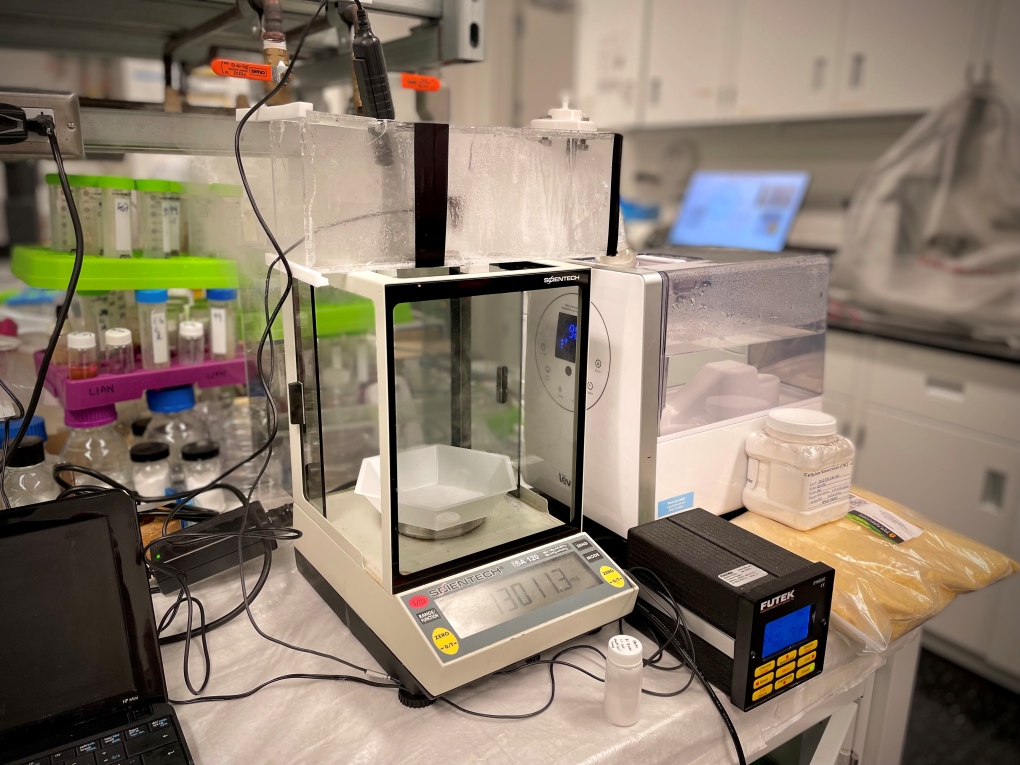University of Waterloo researchers harvest fresh water from thin air, inspired by spider webs and beetles
University of Waterloo researchers hope they've discovered a solution to fresh water scarcity.
The team, led by chemical engineering professor Michael Tam, created a device that captures vapour from the air and turns it into liquid.
Fresh water for consumption is often collected from rivers, lakes, groundwater and oceans, with treatment. But Tam decided to look for inspiration elsewhere, given insufficient fresh water resources around the world.
"When you go hiking, look around, and learn from nature," said Tam, standing in his lab. "If you live in the mountains, there are no rivers or lakes, but there's lots of water in the clouds, the fog."
So Tam asked himself whether it would be possible to capture water that way for consumption. Inspired by insects, he found his answer.
"Spider webs capture water, beetles capture water for consumption," said Tam, who is also a University Research Chair in the field of functional colloids and sustainable nanomaterials.
"The spider doesn't need to go to the river to drink, as it traps moisture from the air," he explained.
Similarly, Namib desert beetles don't have easy access to water but they acquire it from the air by leaning into the wind to capture droplets from the fog with their textured body armour. This allows the moisture to accumulate and drip into their mouths.
 Inspired by insects, the device captures vapour from the air and turns it into liquid. (Spencer Turcotte/CTV Kitchener)
Inspired by insects, the device captures vapour from the air and turns it into liquid. (Spencer Turcotte/CTV Kitchener)
Tam set out to mimic that ability in the lab, by creating an atmospheric water harvesting system. Using a cellulose-stabilized wax emulsion, it attracts tiny water droplets.
"So based on those inspirations, we built the technology using natural material that can capture water. And we found that when we capture one-squared-metre of the surface, we get five litres of water per hour," Tam said.
Tam is working with net-zero carbon materials and is engineering a surface that captures water from the air and dehumidifies it with minimal energy consumption. The process is also inexpensive.
"It refreshes itself and it's what our world needs – something that doesn't pollute," he said. "In the atmosphere, water is free. You don't have to pay for it."
Tam and his team are now looking at harvesting water on a much larger scale.
He wants to deliver his gadget to remote areas that desperately need it. Before that, they have to incorporate an antimicrobial agent to decontaminate the water and make it safe to drink.
"That's our dream," said Tam.
CTVNews.ca Top Stories

Prime Minister Trudeau meets Donald Trump at Mar-a-Lago
Prime Minister Justin Trudeau landed in West Palm Beach, Fla., on Friday evening to meet with U.S.-president elect Donald Trump at Mar-a-Lago, sources confirm to CTV News.
'Mayday! Mayday! Mayday!': Details emerge in Boeing 737 incident at Montreal airport
New details suggest that there were communication issues between the pilots of a charter flight and the control tower at Montreal's Mirabel airport when a Boeing 737 made an emergency landing on Wednesday.
Hit man offered $100,000 to kill Montreal crime reporter covering his trial
Political leaders and press freedom groups on Friday were left shell-shocked after Montreal news outlet La Presse revealed that a hit man had offered $100,000 to have one of its crime reporters assassinated.
Questrade lays off undisclosed number of employees
Questrade Financial Group Inc. says it has laid off an undisclosed number of employees to better fit its business strategy.
Cucumbers sold in Ontario, other provinces recalled over possible salmonella contamination
A U.S. company is recalling cucumbers sold in Ontario and other Canadian provinces due to possible salmonella contamination.
Billboard apologizes to Taylor Swift for video snafu
Billboard put together a video of some of Swift's achievements and used a clip from Kanye West's music video for the song 'Famous.'
Musk joins Trump and family for Thanksgiving at Mar-a-Lago
Elon Musk had a seat at the family table for Thanksgiving dinner at Mar-a-Lago, joining President-elect Donald Trump, Melania Trump and their 18-year-old son.
John Herdman resigns as head coach of Toronto FC
John Herdman, embroiled in the drone-spying scandal that has dogged Canada Soccer, has resigned as coach of Toronto FC.
Weekend weather: Parts of Canada could see up to 50 centimetres of snow, wind chills of -40
Winter is less than a month away, but parts of Canada are already projected to see winter-like weather.


































